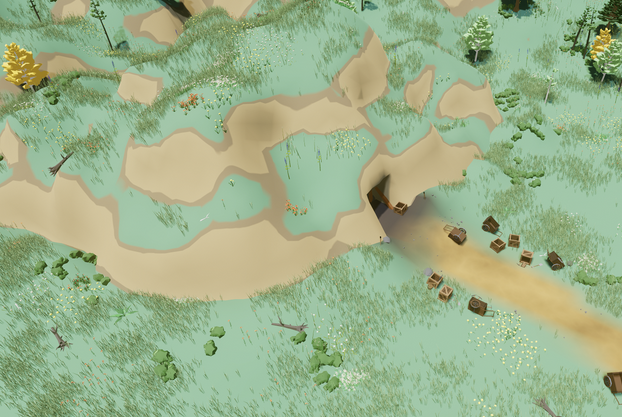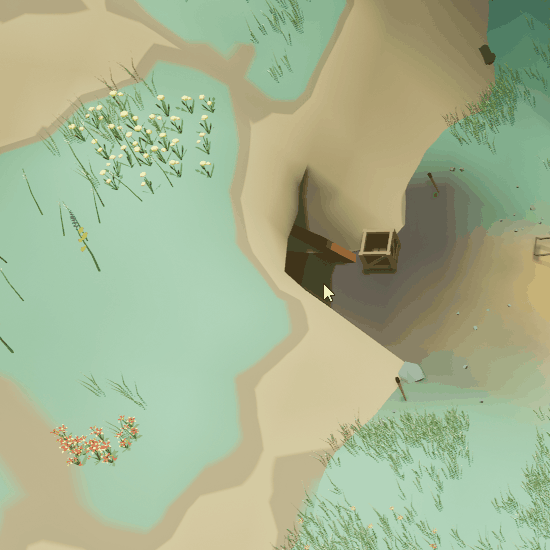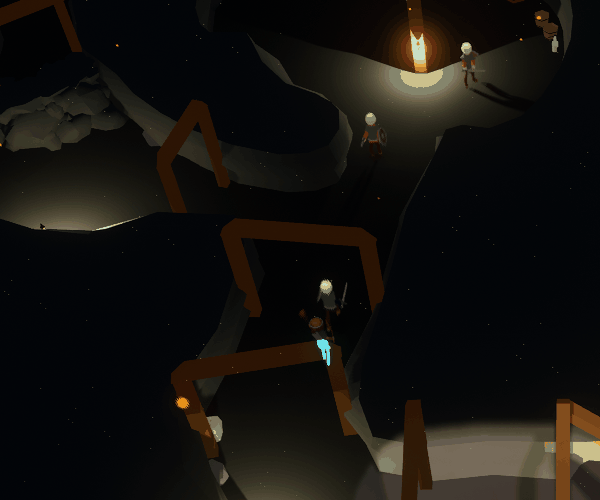Someone Could Fit Through That Window. A Small Person. An Attack Child
May 17th, 2023
While working on a new area, the lead up to a snowy mountain top, we encountered a challenging feature that we wanted to implement. We previously created explorable buildings and wanted to expand this exploration aspect to include underground environments. This post talks about our challenges in making an explorable underground mine.
Why Make A Cave
Since the vast majority of our gameplay has been in outdoor environments, we wanted to ensure that the mines added new mechanics and play styles. Simply making an area that looked different didn’t seem like it would be worth the effort. An underground area would force the player to carefully investigate the blind corners and narrow hallways while defending their caravan from aggressive interlopers. It took much more time than expected to develop, but from this we learned how we can create additional cave-like experiences with (hopefully) minimal pain.

Outside view of the mines
The main challenges of creating the mines were:
- How the player sees the underground mine while also controlling units outside
- How the mine’s interior is lit separately from the lighting outside
- How the units’ AI will work in such a constrained space
Developing The Mines
We wanted the interior of the mines to be traversable seamlessly from the outside. Our plan was to model the exterior of the mines, then cut the top section from the base. This top section would fade out when the player’s units are inside the mine, and would reappear when none were present. This was challenging, as the seam where the base and top met did not connect nicely. The noticeable seam was apparently due to the normal vectors along the seam not being continuous, and we could not find a pleasing solution in making the seam less noticeable. After some thinking, we found our solution: make the top section overlap the entire base. We also made the base about 99% of its usual scale, this prevented any z-fighting between it and the overlapping top. For added flavor, we added foliage on top of the mines that would also be hidden when adventuring inside.
To keep the mine’s interior dark and moody, we added an invisible plane that matches the shape of the interior of the mine. This lightblocker™ is invisible, yet it casts a shadow. Curious. This interesting combination of functionalities in Unreal allows us to prevent any sun/moonlight from entering the mine, and to also not block any of the player’s mouse clicks. With the lightblocker in place, just above the timber propping up the walls and roof of the mine, we could add lanterns containing point lights to illuminate the interior.

Entering the mines
To ensure that the player and enemy units behave as expected, we made the interior walls just above the eye height of the units. This prevents them from seeing each other above the walls, thus ruining any surprises. It took a bit of effort to ensure that the wall height was blocking vision but also not blocking the units from the camera too much. We didn’t want the units to be constantly obscured behind walls. Even though the units would still be clickable behind walls, we felt that keeping them in view would be a more visceral experience.

Fighting in the dark
The last thing we want to add to the mines is some vision blocking fog that disappears when the player’s units touch it. The fog’s purpose is to provide exploration and sudden, unpleasant battles. We’ll end this post here so that we don’t give away too much; there are a few more exciting mechanics within the mines that we can’t wait for our testers to try out!